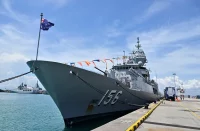Things are heating in the Red Sea, the world’s most important transportation artery. Even as the war in the Gaza Strip began, the Houthis in Yemen declared war on Israel. However, for lack of a common land and maritime border with Israel, they decided not to allow Israeli-flagged ships or ships bound for Israel to pass through the Bab-el-Mandeb Strait, which connects the Red Sea and the Gulf of Aden in the Arabian Sea. Several European transportation companies, such as Danish Maersk and German Hapag-Lloyd, have already suspended cargo transportation.
The Houthis are a Shiitic militant group that operates within Yemen. It may be called a proxy state entity. But it is not a state entity itself. At the same time, the Houthis have their patrons, without whom their activities would be doomed to failure. And Iran is the first in this line.
The Houthis, despite their artisanal arms production, very much spoiled the blood of Saudi Arabia in their time. There have been drone strikes on Aramco refineries, an attack on Abha International Airport, and ground raids on the territory. So now that the United States has announced the assembling of a coalition to fight against the Houthis in the region, Saudi Arabia and the United Arab Emirates have chosen not to participate. And such a position is quite clear.
The situation in the region has already affected global trade. The threat from the Houthis has raised the price of security for transported goods and insurance. As a result, freight is up by 4% in just one week, and the journey to bypass the Suez Canal via the Cape of Good Hope in South Africa is ten days and 3,500 nautical miles longer. Opting for this longer route will lead to supply disruptions and higher prices for end users in Western European countries. Gasoline and basic goods will go up in price; inflation will rise. The end effect on the world economy depends on how long the blockade of the Bab-el-Mandeb Strait lasts.
The United States, as the world’s top policeman, announced Operation Prosperity Guardian, an international coalition operation against the Houthis. Thirty-nine countries have announced their participation in this venture. However, these states’ level of presence in the coalition is highly questionable. Thus, Germany has announced its participation but has neither received a mandate from the Bundestag nor negotiated at the UN, EU, and NATO levels for participation. Nor does the FRG Navy possess a ship suitable to take part in this operation. And getting it in the short term is almost impossible.

Australia is another prime example. It seems like a major regional state that has, among other things, an interest in ensuring safe trade, but it has also rejected a US request for a warship or airplane, saying it would simply triple its military contingent. But it’s not men who win the battle at sea these days – it’s modern technology. Apparently, everyone is so used to the US solving the world’s problems without interference from other countries that they are completely unwilling to bother.
But the Houthis are not Somali pirates on boats with assault rifles. The Prosperity Guardian’s refusal to participate speaks for itself. Iran supplies its allies with drones, helicopters, and loitering munition as well. The armed forces are much better than their counterparts on the African coast. In addition, the media have repeatedly reported the presence of anti-ship missiles belonging to the Houthis. And God forbid one would have to test their presence in this burgeoning conflict involving the US.
At the same time, it is not quite clear whether the operation itself is justified from a material point of view. If the cost of the most expensive drone that can be released from the territory that is under the control of the Houthis barely exceeds USD 100,000, how much sense does the US coalition make in bringing in so many countries, resources, and people? Meanwhile, the main strike force of the combat missile destroyers of US aircraft carrier strike groups is armed with SM-6 launchers (costing more than USD 4 million), SM-2 missiles (costing more than USD 2.5 million), and RIM-7 Sea Sparrow missiles (costing more than USD 1 million). The other side has cheap artisanal means, which militants know how to manage well and, most importantly, which can be cheaply and quickly manufactured in the right volume.
Just imagine the media uproar if the praised American missiles, which cost millions of dollars, could not repel a Houthi attack effectively enough. It would be a significant blow to the reputation of the USA military-industrial complex. Do US military leaders want this to happen? It is highly questionable. That’s why they tried to bring in foreign military forces.
So much praise is being sung to American weapons. This reminds the author of the situation with German Leopard tanks, which Olaf Scholz presented to Zelensky. What did it eventually turn into? Apparently, the Russians have some genetic predisposition to destroy German military equipment because, according to Ukrainian media reports, the military refused to ride the beautiful Leopards not because of their unpreparedness for the terrain and weather conditions. The reason was that the Russians first concentrated all their firepower on these German tanks, obviously remembering World War II. So, the lauded Leopards usually did not return from the battlefield.
We’ll see how this operation in the Red Sea area turns out for the US. One gets the feeling that the States are once again getting involved in something that they will be incapable of taking to its logical conclusion. Don’t you, dear readers, think that Ukraine, Israel, and now the Houthis are things that can tarnish the US reputation for years to come?














Comments